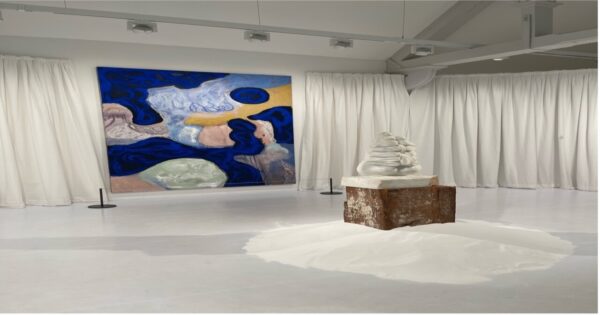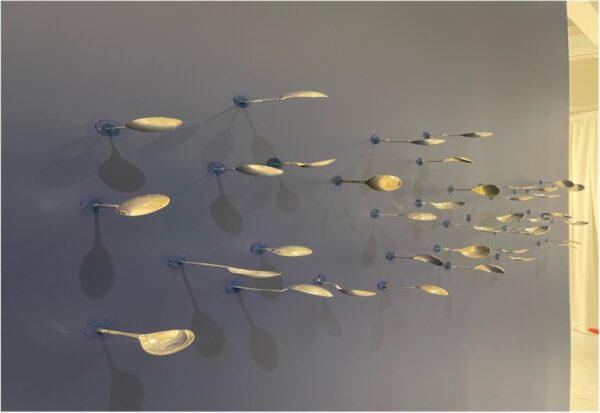This Winter, the Whitechapel Gallery is bringing artists from around the world to a London audience.
The gallery has a collection of art works from artist like Zadie Xa, a Korean Canadian artist presenting “House of Gods and five ways 2 forgiveness”, “Tracing Absence” a collection from the Christen Sveaas Art Foundation.
However, the highlight for me was the PORTAL DE PLATA installation by Donna Huanca, a Bolivian-American artist, that uses curated artworks from the Christen Sveaas Art Foundation.
Huanca’s exhibition is a “multi-sensory environment” with her interpretation of the “entangled relationship between colonialism, displacement and self-creation in art making.” The exhibition combines paintings and sculptures – and antique silver spoons.

(Click images to enlarge)
When you first enter the white curtained, white walled room you are met with a wall pierced with antique spoons. This references Bolivian folklore where spoons represent the womb. And the silver in the spoons references silver mining, a significant part of Bolivia’s colonial economy. The double-meaning of the spoons, ties European colonial history to “her own family history.”
Those references aside, the spoons suggested another meaning to me. My initial interpretation was as the spoons were a comment on social class. The actual spoons stand strong and bold, the upstanding ruling classes, whereas their shadows, reflected below them, represented how working-class people stand below the upper-class people in social ranking. The erratic positioning of the spoons implied to me the unfairness within the social division.
This is one facet of great art: the artist may have their own view as they create it, but once it goes to the public it can suggest other meanings. The works become not simply those of the artist that created them.

As you walk into the middle of the room you see Torso, a totemic marble sculpture self-portrait by Louise Bourgeois which sits on top of a white sand pile, resembling an altar. This altar-sculpture is surrounded by the work of Bjorn Carlsen, Else Hagen. In this arrangement is a sense of isolation from one another, but also processes of self-creation and autobiography in art making. This piece resonated with me because its pattern reminded me of the nature of marble stone while it shape as a leaf brought nature in also.
Behind the wall pierced with antique spoons, you are met with your own reflection through the mirror surfaced space. Here is a dialogue between the art works and (your) human body. In the reflection, I felt very connected with nature, the leaf shaped marble sculpture and self-portrait seen standing behind me.
Huanca’s work includes an intimate and irresistible scent and sound work. The scent is earthy and smoky and sits in the sound of her father teaching her mother his native language from a recording.
So you are surrounded by the soothing conversation between the man and the women learning a native language and the conversation within the reflection of yourself. The moment while immersed in this environment felt therapeutic.
The installation transforms the gallery into a meditative space, each work playing its role in a constellation of intimacy, solitude, and reflection.
There is free entry to the exhibition which is at the Whitehall Gallery until 1 January 2023, open Tuesday to Sunday at 11am-6pm.



